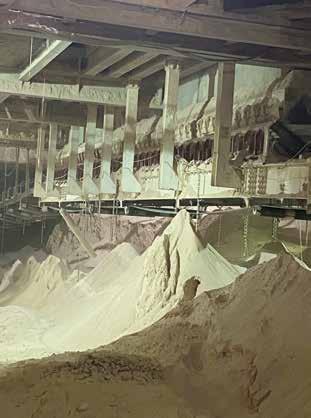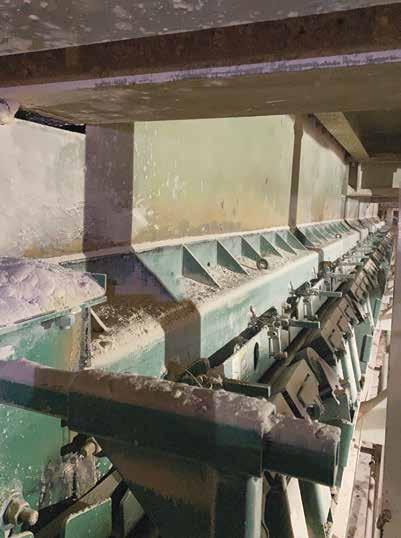
3 minute read
Properly identifying root causes assures successful material and dust containment
Potash application before.
Conveyor belt support and sealing. fugitive dust is a continuous problem for the material handling industry. any time there is material movement, dust can be generated. side effects of this issue include the negative impacts on operational health, safety, and efficiency. these must be resolved to avoid constant clean-up tasks, loss of product, equipment damage, and health and environmental concerns.

recently, richwood was invited to help mitigate persistent dust generation issues for a potash client in Canada. though there were several sources of dust in this application, the assignment was to seal and contain a busy load zone. the approach, recommendations, and results are presented here.
Identifying root causes for the escaping material was the first step. though it would be simple to prescribe canoe liners, skirting, and skirt clamps and call it a day, this would be an over-simplified view of transfer areas. a thorough survey to evaluate the system operating conditions and requirements was conducted. factors noted include: conveyor belt width, belt operating speed, type of material conveyed, the conveyor profile, tons per hour, the design of the transfer chute, type of belting and types of splices, as well as other details that effect the performance of the conveyor.
successful dust containment is built from the bottom up and this application was no different. During the inspection it was noted that there were a few ineffiencies that needed to be corrected to help contain more material and dust particles. these issues were most evident when cleaning, when the amount of dust generated would be considerable enough to make for very low visibility, further underscoring the necessity to resolve this problem.
a complete Material Containment system was recommended that was designed and built from the underside of the belt up. It included impact systems with a true radius conveyor belt support profile. best practice design standards for bulk handling belt conveyors begin with a full trough transition entering the load zone. this places the belt in full contact with belt support components at all times, establishing the consistent foundation for the sealing system. any reliable system requires a straight, stable bedrock of support. this basic requirement is often overlooked and is critical to successful system results.
Next, material containment that includes a multi-layer sealing system to effectively contain both heavy bulk material and fines was recommended and engineered for the location. this multi-layer design approach uses internal wear liners to seal bulk material inside skirtboards while protecting against abrasive wear with the flexible outer skirting media dedicated exclusively to the containment of fine dust.
the installation of all components was assisted by the richwood technical support team.
the results, especially the cleaner and safer work area for staff, have been a great benefit to the client. additionally, any conveyor maintenance or inspections needed in the area are much easier to perform. before the material containment system installation, there was a huge amount of dust escaping the skirted area of the conveyor, creating large product losses and cleanup costs. since the Material Containment system installation was completed, the remaining dust that collects in the area filters down from the processing floor above. though overhead conditions above the tunnel still release dust, cleanup from material escaping from the conveyor has been drastically reduced. the cost savings realized here will continue to provide a consistent return on investment in safety, work hours, and components.
Conveyor transfers have their own unique characteristics that must be accurately identified and incorporated into the system design process. best results for effective dust control are realized through a total system design for each individual application.
for more information, contact richwood at www.richwood.com. s
Impact saddles and skirt clamps.

Worry-Free Load Zones
Rely on Richwood Load Zones. Worry-Free by Design.
Clean-up costs, lost product, safety and environmental issues are a real risk to productivity. A Richwood designed load zone can solve these common problems, making your loading and transfer areas worry-free. What would it mean for your productivity if loading and spillage issues were eliminated?
Contact Richwood today for an on-site evaluation.
Rely on
RICHWOOD IMPACT SADDLES ®
BEFORE


AFTER www.richwood.com (800) 237-6951 | +1(304) 525-5436 | info@richwood.com
©Richwood 2020










